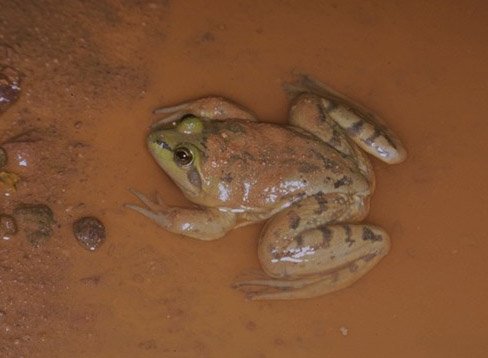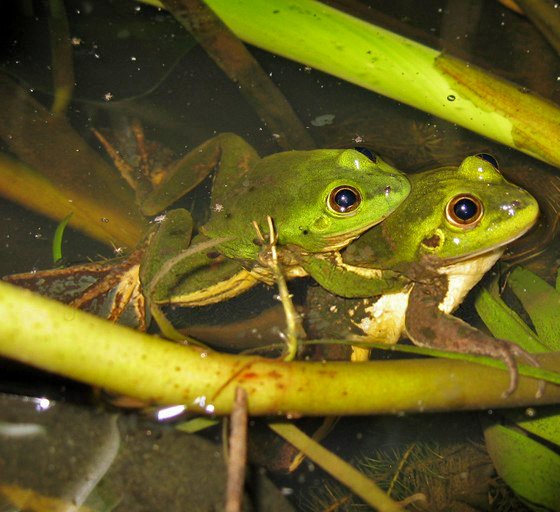Welcome to another post of my strange animals series where you get to meet some of the weirdest, coolest, and craziest animals from all around the world!
Today I want to talk about what is definitely one of the weirdest frogs out there. Unlike most of the creatures featured on my blog, this one looks pretty normal:

Pseudis paradoxa (credit)
Scientifically described as Pseudis paradoxa, the frog above is commonly known as the paradoxical frog. But what is it that makes this cute green frog....paradoxical?
Well, as you probably know most frogs have a pretty straightforward life cycle, starting with an egg that hatches into a tadpole which gradually develops into a frog. And as you also probably know, each stage is bigger in size than the previous...After all, babies grow bigger..Or maybe not?
So here's the deal with P. paradoxa. This guy literally grows down instead of growing up! Fully grown tadpoles are about 25 cm (10 inches) long but fully formed adult frogs are only about a quarter of that length. It literally shrinks down as it gets older, hence the other common name for the species, the "shrinking frog".
Why and how these frogs undergo such a strange transformation is something we still don't know. Actually, before this was observed in the lab, researchers thought that tadpoles and adults belonged to two different species.

Paradoxical frog adult vs tadpole model (credit)
Ok, now that we know why Pseudis Paradoxa is paradoxical it's time to learn a bit more about its biology:
Where Can I Find One?
Individuals can be found in "ponds, lakes and lagoons from northern Argentina, through the Pantanal, Amazon and the Guianas, to Venezuela and Trinidad, with a disjunct distribution in the Magdalena River watershed in Colombia and adjacent far western Venezuela." [1]

Pseudis paradoxa in a pond (credit)
What Do They Eat?
Their diet consists of larvae, small insects, invertebrates and other small animals, including other, smaller than themselves, frogs.
What About Sex?
Although we don't know all the details about their reproductive patterns, there doesn't seem to be anything special or unusual about the reproduction of the species, other than it seems to connected with abrupt rainfall:
"When it is time to mate, the males assemble at a body of water and call females to the site. The males then mount the female and fertilize the eggs as the females release them. The female lays the eggs among water plants and they develop into tadpoles. The eggs that are laid have a greenish frothy appearance. The tadpoles that then hatch have a greenish colour as a result and they keep this colour for several days. They then grow at an extraordinary rate and obtain a size about 25cm which is about four times the size of the adult " [3]

Who's your daddy? (credit)
Are They Threatened?
The species doesn't appear to have any major threats, although there is some pressure on certain localized populations due to human related activities like agriculture and deforestation. At the moment, it's listed by the IUCN as least concern due to "its wide distribution, tolerance of a broad range of habitats, presumed large population, and because it is unlikely to be declining to qualify for listing in a more threatened category." [5]
I am hungry. Can I eat one?
I couldn't find anything about this frog being toxic so my guess is, yes you can eat one!
Some Other Quick & Interesting Facts
- In captivity a specimen once lived for 11 years. Their average lifespan in the wild is unknown
- A study in 2008 found that synthetically produced pseudin-2, a compound first isolated from the skin of P. paradoxa which protects it from infections, can stimulate the secretion of insulin in pancreatic cells under laboratory conditions without toxicity to the cells. The authors of the paper hope that one day this "may have potential for development as a therapeutically valuable insulinotropic agent for the treatment of type 2 diabetes. " [6]
The End
This is pretty much all the basics you need to know about the paradoxical frog. Make sure to visit the links provided in the references if you want to learn more!
More Strange Animals
- You Won't Believe What This Tiny Baby Fish Grows Out To Be
- This Alien-like Worm Will Freak You Out!
- Cymothoa exigua: The Parasite That Turns Into A Tongue ?!?!
- 8 Strange Animal Stuff I Learned The Past Few Days #1
- New Cave Dwelling Animal Discovered With The Help Of Smelly Cheese
- Animals Named After Donald Trump
- The Bernie Sanders Spider
References
- Wikipedia.org/wiki/Pseudis_paradoxa
- Eol.org/pages/1039263/details
- Sta.uwi.edu/fst/lifesciences/documents/Pseudis_paradoxa.pdf
- Itsnature.org/sea/other/paradoxical-frog/
- Iucnredlist.org/details/55904/0
- Degruyter.com

Steemstem & SteemitEducation
Steemstem is the go-to place for science on Steemit. Check it out at @steemstem or visit the #steemSTEM channel. A big thank you also goes to the guys from @steemiteducation for supporting my content!
Greek Community
A final big thanks goes to my fellow greeks for their support and love. Follow the greek-trail or check the facebook page for more greek content!

